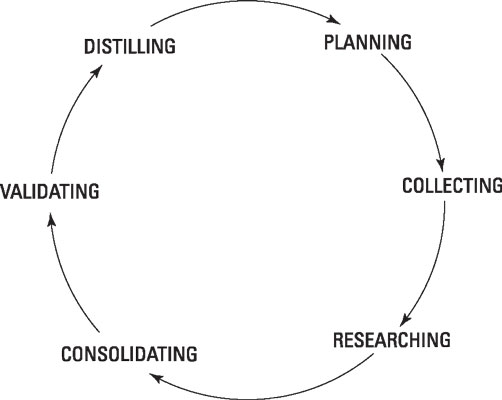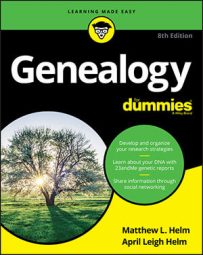Not everyone enjoys coming up with a plan. Finding your ancestors is the fun part — not the planning. So, to help speed things along, the Helms have come up with a basic process that they hope helps you make the most of your research time — the Helm Online Family Tree Research Cycle. Most of this plan is common sense. The figure shows the six phases of the cycle: planning, collecting, researching, consolidating, validating, and distilling.
 The Helm Online Family Tree Research Cycle.
The Helm Online Family Tree Research Cycle.Sticking with the family tree motif here, we liken the cycle to the steps you take to plant and sustain a tree:
- Planning: The first step in planting a tree is figuring out what kind of tree you want and then finding a good place in your yard for the tree to grow. This step in the cycle is the planning phase. In genealogy, the planning phase consists of selecting a family that you know enough about to begin a search and thinking about the resources that can provide the information that you're looking for.
- Collecting: After you plan for the tree, you go to a nursery and pick a suitable sapling and other necessary materials to ensure that the tree's roots take hold. The second phase of the cycle, collecting, is the same — you collect information on the family that you're researching by conducting interviews in person, on the phone, or through email, and by finding documents in attics, basements, and other home-front repositories.
- Researching: The next step is to actually plant the tree. You dig a hole, place the tree in it, and then cover the roots. Similarly, you spend the researching phase of the cycle digging for clues, finding information that can support your family tree, and obtaining documentation. You can use traditional and technological tools to dig — tools such as libraries, courthouses, your computer, and the web.
- Consolidating: You planted the tree and covered its roots. However, to make sure that the tree grows, you put mulch around it and provide the nourishment that the tree needs to survive. The consolidating phase of the cycle is similar in that you take information you find and place it into your computer-based genealogical database or your filing system. These systems protect your findings by keeping them in a centralized location and provide an environment in which you can see the fruits of your labor.
- Validating: To ensure that you're providing your tree with all the nutrition and care that it needs, you might pick up a book or watch a gardening show to confirm that your actions will nurture the tree. The validating phase in genealogy allows you to do the same with your research. By using additional research tools and by finding multiple sources, you can feel more confident that your discoveries are placing your research on the right track.
- Distilling: After your tree takes root and begins to grow, you need to prune the old growth, allowing new growth to appear. Similarly, the distilling phase is where you use your computer-based genealogical database to generate reports showing the current state of your research. You can use these reports to prune from your database those individuals you've proven don't fit into your family lines — and perhaps find room for new genealogical growth by finding clues to other lines with which you want to follow up.

